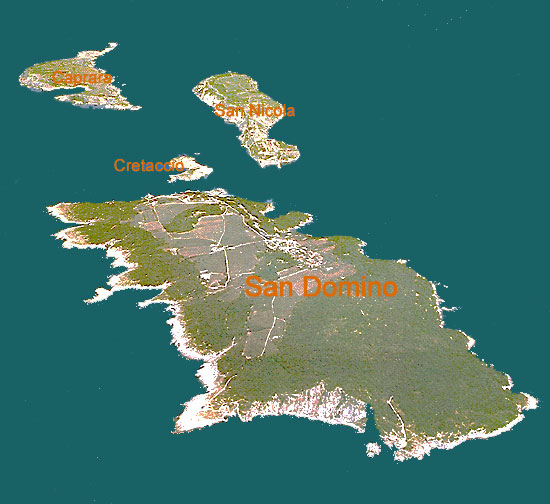TREMITI ISLANDS
The
Tremiti Islands (the green San Domino, the rough San Nicola and the wild Caprara)
lie 22 miles from the Gargano promontory (province of Foggia) and are also known
as the pearls of the Apulian Adriatic Sea. The other three isles located further
out (Pianosa, Pelagosa Grande and Pelagosa Piccola) and a small group of 16
minor crags are part of the same group of islands .

Aerial view of the Tremiti islands -
Map
of the Tremiti Islands -
The island of San Nicola still has the
threatening look of its one-time function as defence against pirates, though it
is now the paradise of underwater fishermen

Tremiti. The island of San Nicola. An uphill
road towards the Castello delle Badia
Most of them are protected by a marine park which includes three areas: the
first area includes Pianosa; the second area includes Caprara and the coast of
San Domino, from the Faro di Punta Diavolo to Punta Secca; and the third area
includes the waters up to 70 meters from the coast (no professional fishing is
allowed). Due to their calcareous nature, the group of islands was probably
formed after breaking
away from a strip of land. It was probably due to telluric movements that
occurred during the formation of the islands that Tacitus named them "Tremerum"
(subject to tremors). This is the probable origin of their current name,
although they are no longer subject to
 tremors. These islands are the ideal
destination for sea-lovers who willingly do without the noise of typical "fun-filled"
holidays. No need to have a car, as San Domino (the largest of the islands) can
be crossed on foot in 20 minutes.
tremors. These islands are the ideal
destination for sea-lovers who willingly do without the noise of typical "fun-filled"
holidays. No need to have a car, as San Domino (the largest of the islands) can
be crossed on foot in 20 minutes.
Caprara
Besides being the smallest (0.15 sq.miles) and the only uninhabited Tremiti
Island, Caprara is also the furthest from the Italian coast. Once it was called
"Capperaia" due to the abundance of caper plants that still grow there. This
flat-looking island has only one uneven point: the 53-metre-high Monte Grosso.
Once Caprara was fertile and green (its lands were once cultivated by monks who
lived there), but today it is covered by a scarce vegetation mainly consisting
of lentiscus. It is connected to the main Tremiti Island by a local boat service.
Its only buildings are the Casa dei Coatti (first used as an isolation site for
prisoners and later as a farm) and the Faro della Marina (lighthouse).
 San Domino
San Domino
This is the biggest of the Tremiti Islands although it has a surface of only
0.81 sq.miles. It is also the best organised from the touristic point of view,
It is the only island where there is a wide selection of accommodation
alternatives. San Domino has many grottos and is covered by a vegetation
emitting a scent of pines and orange blossom that is worth the name given to San
Domino: "the green pearl of the Adriatic Sea". Plants in full bloom are a very
common and characteristic peculiarity of the pine-wood situated in the
south-western part of the island where you can see myrtles, geraniums and Indian
figs. San Domino is also the kingdom of cicadas and birds such as the Diomedeas
which produce a peculiar moan at night. The legend says that the Diomedeas are
the soldiers of Homer's hero Diomede who were transformed into birds by Venus
and forced to watch over the islands that had been chosen as the home of the
warrior. In addition to its nature, the island also has an ancient history (as
the numerous remains found confirm). San Domino has been inhabited since the 2nd
millennium B.C. and was subsequently visited by the Greeks and Romans. In the
year 1000 it was chosen as a hermitage by the Benedictine monks who later left
the island and settled in San Nicola. All the hotels of the Tremiti Islands are
on San Domino. The connections with the main-land are excellent: those with a
limited time can use the all-year-round helicopter service from Foggia.

Tremiti - Island of San
Nicola. This arch was probably at one time a defence
against Turks and pirates |

Diomedea
|




